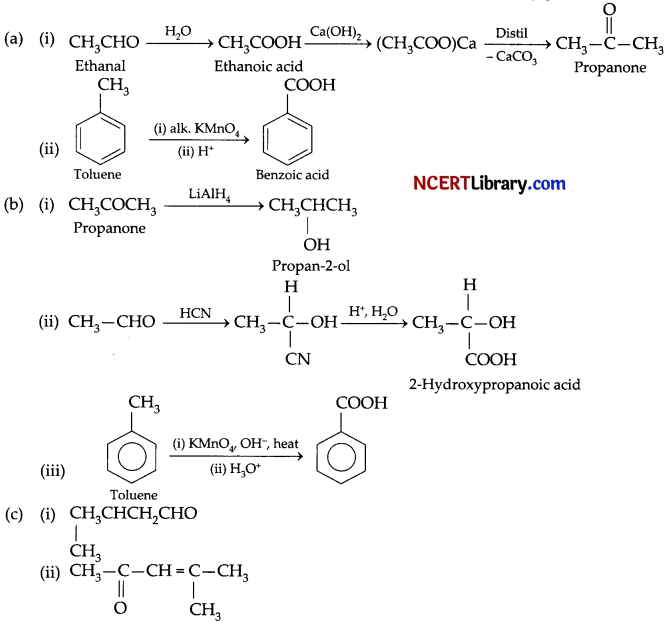Practicing the CBSE Sample Papers for Class 12 Chemistry with Solutions Set 3 allows you to get rid of exam fear and be confident to appear for the exam.
CBSE Sample Papers for Class 12 Chemistry Set 3 with Solutions
Time : 3 Hours
Maximum Marks: 70
General Instructions :
Read the following instructions carefully.
- There are 35 questions in this question paper with internal choice.
- SECTION A consists of 18 multiple-choice questions carrying 1 mark each.
- SECTION B consists of 7 very short answer questions carrying 2 marks each.
- SECTION C consists of 5 short answer questions carrying 3 marks each.
- SECTION D consists of 2 case-based questions carrying 4 marks each.
- SECTION E consists of 3 long answer questions carrying 5 marks each.
- All questions are compulsory.
- Use of log tables and calculators is not allowed
Section – A
The following questions are multiple-choice questions with one correct answer. Each question carries 1 mark. There is no internal choice in this section.
Question 1.
The catalyst used in Rosenmund’s reduction is: [1]
(a) HgSO3
(b) Pd/BaSO4
(c) anhydrous AlCl3
(d) anhydrous ZnCl2
Answer:
(b) Pd/BaSO4
Explanation: A catalyst used in Rosenmund’s reaction can be prepared by reduction of palladium(II) chloride solution in the presence of BaSO4.
The palladium catalyst used in Rosenmund’s reduction must be poisoned with BaSO4 because the untreated catalyst Palladium (Pd) is too reactive and will undergo over reduction forming other products.

Question 2.
Anomalous electronic configuration in the 3d series are of: [1]
(a) Cr and Fe
(b) Cu and Zn
(c) Fe and Cu
(d) Cr and Cu
Answer:
(d) Cr and Cu
Explanation: Cromium (Cr) and copper (Cu) are the exceptions of 3-d transition series which show anomalous electonic configuration. Cr and Cu attain extra stability of half-filled and full-filled electronic configuration by changing the expected pattern of electronic configuration.
The electronic-configuration of Cr and Cu is [Ar] 3d5 4s1 and |Ar] 3d10 4s1 respectively. In both cases, an electron from the 4s orbital jumps to 3d subsheell as it is more stable due to half- filled and full-filled stable configuration.
![]()
Question 3.
The double Helix is found in: [1]
(a) DNA
(b) RNA
(c) Proteins
(d) Carbohydrates
Answer:
(a) DNA
Explanation: The double helix in DNA consists of two right-handed polynucleotide chains that are coiled about the same axis. The heterocyclic amine bases project inward toward the centre so that the base of one strand interacts or pairs with a base of the other strand.
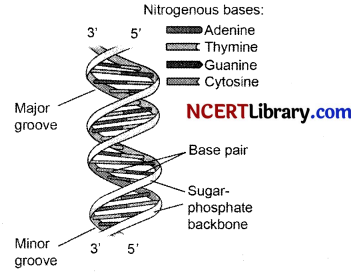
Question 4.
Reduction of CH3CH2NHC with hydrogen in presence of Ni or Pt as catalyst gives: [1]
(a) CH3CH2NH2
(b) CH3CH2NHCH3
(c) CH3CH2NHCH2CH3
Answer:
(b) CH3CH2NHCH3
Explanation: The reduction of isonitrile with hydrogen in presence of Ni or Pt is known as catalytic hydrogenation. The – NC is known as isonitrile. In isonitrile, the negative charged carbon work as a nucleophile. It attacks hydrogen and gets protonafed. The triple bond shifts to the nitrogen and the lone pair of the nitrogen attacks on another hydrogen and the breaking of the N = C bond results in the secondary amine. Thus, the reduction of CH3CH2NC with hydrogen in presence of Ni or Pt as catalyst gives CH3CH2NHCH3.

Question 5.
What is the IUPAC name of

(a) 2-dimethylchloropropane
(b) 1-chloreo-2-dimethy 1-pentane
(c) 2, 2-dimethyl-chlorobutane
(d) 1-chloro-2, 2-dimethyl propane [1]
Answer:
(d) 1-chloro-2, 2-dimethyl propane
Explanation: According to IUPAC Nomenclature, the name of the given compound is 1-chloro-2,2- dimethyl propane.
Question 6.
The rate of a chemical reaction: [1]
(a) Increases as the reaction proceeds.
(b) Decrease as the reaction proceeds.
(c) May increase or decrease during the reaction.
(d) Remains constant as the reaction proceeds.
Answer:
Decrease as the reaction proceeds.
Explanation: The rate of chemical reaction is directly proportional to the concentration of the reactants i.e., rate of reaction decreases with decrease of concentration and increases with increase in concentration. As the reaction progresses the reactant is converted into the product and thus the concentration of reactants decreases while that of the products increases.
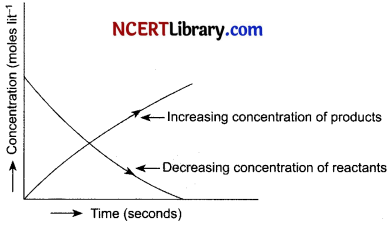
Question 7.
A fruity smell is produced by the reaction of C2H5OH with: [1]
(a) PCl5
(b) CH3COCH3
(c) CH3COOH
(d) None of these
Answer:
(c) CH3COOH
Explanation: Ester can be identified by fruity smell at the end of reaction. When alcohol is treated with acid, alcohol gets protonated via H2SO4 and attacks acid thus, formation of Ester and removal of water molecule can take place. Ester can be identified by fruity smell at the end of reaction.

Question 8.
A liquid pair of benzene-toluene shows: [1]
(a) Positive deviation from Raoult’s law.
(b) Negative deviation from Raoult’s law.
(c) Practically no deviation from Raoult’s law.
(d) Irregular deviation from Raoult’s law.
Answer:
(c) Practically no deviation from Raoult’s law.
A B
Explanation: Liquid pair benzene – toluene shows practically no deviation from Roult’s law as there is A – B ≈ A-A and B-B interaction.
![]()
Question 9.
The standard electrode potentials of four elements A, B, C and D are – 3.05, 1.66, – 0.40 and 0.80 volts respectively. The highest chemical activity will be shown by: [1]
(a) A
(b) B
(c) C
(d) D
Answer:
(a) A
Explanation: Lower the reduction potential better will be reactivity or chemical activity. Among A, B, C and D, Standard electrode potential i.e., reduction potential of A is minimum (-3.05 V) i.e., its oxidation potential is maximum which implies ‘A’ has maximum chemical reactivity.
Question 10.
Identify the correct naming for K3[Fe(CN)6]. [1]
(a) Tripotassium hexacyanidoferrate(III)
(b) Potassium hexacyanoferrate(II)
(c) Tripotassium hexacyanoferrate(III)
(d) Potassium hexacyanidoferrate(III)
Answer:
(d) Potassium hexacyanidoferrate(III)
Explanation: According to the IUPAC nomenclature, the IUPAC name of K3[Fe(CN)6] is potassium hexacyanidoferrate (III).
Question 11.
Consider a reaction aG + bH → products. When concentration of both the reactants G and H is doubled, the rate increases by eight times. However, when concentration of G is doubled keeping the concentration of H fixed, the rate is doubled. The overall order of the reaction is: [1]
(a) 0
(b) 1
(c) 2
(d) 3
Answer:
(d) 3
Explanation: aG + bH → products
Suppose order of reaction = n
When concentration of both C and H doubled then rate increase by eight times.
Rate = K(reactants)n
(8) = K(2)n
(2 )3 = K(2)n
n = 3
When concentration of G is doubled keeping the concentration of fixed, the rate is double.
Then, rate ∝ [G]1
rate ∝ [G]1 [H]2.
Question 12.
The IUPAC name of CH3COCH(CH3)2 is: [1]
(a) 2-methyl-3-butanone
(b) 4-methylisopropyl ketone
(c) 3-methyl-2-butanone
(d) Isopropylmethyl ketone
Answer:
(c) 3-methyl-2-butanone
Explanation: The longest chain is of four carbon. The functional group here is keto group. The numbering will start from left carbon as the functional group should also have the lowest numbering. The substituent methyl group will be at third carbon.
Hence, the IUPAC name of this structure is 3-methyl-2-butanone.
![]()
Question 13.
Which of the following has the maximum number of unpaired electrons? [1]
(a) Mg2+
(b) Ti3+
(c) V3+
(d) Fe2+
Answer:
(d) Fe2+
Explanation: Let us compare the electronic configuration of these elements:
Mg2+ : 1s22s22p6: no unpaired electron.
Ti3+ : 1s22s22p63s23p63d1: one unpaired electron.
V3+ : 1s22s22p63s23p63d2 : two unpaired electrons.
Fe2+ : 1s22s22p63s2sp63d6 : four unpaired electrons.
Thus, we see that Fe2+ has the most unpaired electrons.
Question 14.
When acetaldehyde is heated with Fehling’s solution it gives a precipitate of: [1]
(a) Cu
(b) CuO
(c) Cu2O
(d) Cu(OH)2
Answer:
(c) Cu2O
Explanation: Fehlings solution is a tartaric acid complex of cupric ions.
When acetaldehyde is heated with Fehling’s solution, it gives a red precipitate of Cu20.

Acetaldehyde is oxidised to acetate ion and cupric ions are reduced to cuprous oxide.
Question No. 15 to 18 consist of two statements – Assertion (A) and Reason (R). Answer these questions selecting the appropriate option given below:
(a) Both A and R are true and R is the correct explanation of A.
(b) Both A and R are true but R is not the correct explanation of A.
(c) A is true, but R is false.
(d) A is false, but R is true.
Question 15.
Assertion (A): Ethers behave as bases in the presence of mineral acid. [1]
Reason (R): Due to the presence of lone pair of electrons on the oxygen atom.
Answer:
(a) Both A and R are true and R is the correct explanation of A.
Explanation: Due to the presence of lone pair of electrons on oxygen atom. Ethers behave as base and form stable oxonium salts with mineral acid. Thus, both assertion and reason are correct statements and reason is the correct explanation of assertion.

Question 16.
Assertion (A): In presence of enzyme, substrate molecule can be attacked by the reagent effectively. Reason (R): Active sites of enzymes hold the substrate molecule in a suitable position. [1]
Answer:
(a) Both A and R are true and R is the correct explanation of A.
Explanation: In the presence of enzyme, substrate molecule can be attacked by a reagent effectively because active sites of enzymes hold the substrate molecule in a suitable position. So, enzyme catalysed reactions are stereospecific reactions. Thus, both assertion and reason are correct statements and reason is the correct explanation of assertion.
Question 17.
Assertion (A): Kohlrausch law does not help to find the molar conductivity of weak electrolyte at infinite dilution.
Reason (R): Molar conductivity of a weak electrolyte at infinite dilution cannot be determined experimentally. [1]
Answer:
(d) A is false, but R is true.
Explanation: According to Kohlrausch’s law the molar conductivity of an electrolyte at infinite dilution is equal to the sum of the conductances of the anions and cations.
μ∞ = mλ+∞+ nλ–∞
r = molar conductance at infinite dilution.
λ+, λ– = conductance of cations and anions. m, n = number of ions formed.
So, Kohlrausch law helps to find molar cooductivity of weak electrolyte and infinite dilutions.
The conductance of weak electrolytes is low and even at infinite dilution the dissociation of electolyte is not complete, so the molar conductivity of a weak electrolyte at infinite dilution cannot be determined experimentally. Thus, assertion is wrong statement but reason is correct statement.
Question 18.
Assertion (A): Tetrahedral complexes do not show geometrical isomerism.
Reason (R): Unidentate ligands attached to the central metal ion are same. [1]
Answer:
(a) Both A and R are true and R is the correct explanation of A.
Explanation: Tetrahedral complexes do not show geometrical isomerism because relative positions of the unidentate ligands attached to the central metal atom are same with respect to each other. This type of isomerism arises in heteroleptic complexes. Thus, both assertion and reason are correct statements and reason is the correct explanation of assertion.
Section – B
This section contains 7 questions with internal choice in two questions. The following questions are very short answer type and carry 2 marks each.
Question 19.
Use Hund’s rule to derive the electronic configuration of Ce3+ ion and calculate its magnetic moment on the basis of ‘spin-only’ formula. [2]
Answer:
Electronic configuration of Ce : 1s² 2s² 2p6 3s2 3p6 3d10 4s2 4p6 4d10 5s2 5p6 4f1 5d1 6s2.
Ce3+ : [Xe] 4f
Magnetic moment can be calculated as:
μ = \(\sqrt{n(n+2)}\)
Where,
n = Number of unpaired electrons
For Ce3+ = 54[Xe]4f1(only one unpaired electron)
i.e., n = 1
According to ‘spin-only’ formula,
Magnetic moment of Ce3+ (μ) = \(\sqrt{n(n+2)}\) BM
= \(\sqrt{1(1+2)}\) BM
= \(\sqrt{3}\) BM
= 1.73 BM
Question 20.
A solution is obtained by mixing 300 g of 25% solution and 400 g of 40% solution by mass. Calculate the mass percentage of the resulting solution.
OR
Calculate the osmotic pressure in Pascals exerted by a solution prepared by dissolving 1.0 g of polymer of molar mass 185,000 in 450 mL of water at 37°C. [2]
Answer:
300 g of 25% solution contains solute = \(\frac{300 \times 25}{100}\) = 75 g
400 g of 40% solution contains solute = \(\frac{40 \times 40}{100}\) = 100
Total mass of solute = 160 + 75 = 235 g
Total mass of solution = 300 + 400 = 700 g
Percentage of water in the resulting solution = \(\frac { 235 }{ 700 }\) x 100 = 33.5
Percentage of water in the resulting solution = 100 – 33.5 = 66.5%.
OR
It is given that
Volume of water, V = 450 mL = 0.45 L
Temperature, T = (37 + 273)K = 310 K
Number of moles of the polymer, n = \(\frac { 1 }{ 185000 }\)
We know that,
π = \(\frac { n }{ V }\) RT
Osmotic pressure = \(\frac { 1 }{ 185000 }\) mol x \(\frac { 1 }{ 0.45 L }\) x 8.314 x 10³ Pa LK-1 mol-1 x 310 K
= 30.98 Pa = 31 Pa (Approx.)
![]()
Question 21.
(a) Write the major product of the following reaction: [2]

(b) What is Saytzeff rule? Illustrate with suitable example.
OR
(a) What happens when benzyl chloride is boiled with aqueous sodium hydroxide solution?
(b) What is meant by chirality of a compound? Give an example.
Answer:
(a) 
(b) There are haloalkanes that can undergo elimination in two different ways resulting in two different products. Alkenes with less number of hydrogens on the double-bonded carbon atoms are the preferred product. This process is known as Saytzeff’s rule. According to Saytzeff’s rule in dehydrohalogenation reactions, the preferred product is that alkene which has the greater number of alkyl groups attached to the doubly bonded carbon atoms.

OR
(a) Benzalchloride, undergoes hydrolysis and forms benzaldehyde.

(b) A compound with no point of symmetry and which is non-superimposable on its mirror image is called a chiral compound and the property is called chirality.

Question 22.
How will you convert nitrobenzene to aniline? [2]
Answer:
Aniline is obtained from nitrobenzene by reduction with Sn/Conc. HC1. The chemical reaction can be represented as follows:
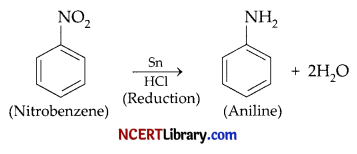
Question 23.
Distinguish between order and molecularity of a reaction. [2]
Answer:
| Order | Molecularity |
| 1. It is the sum of the power of the reacting species involved in rate law equation. | It is the number of reacting species involved in the elementary single step reaction. |
| 2. Order of reaction is determined experimentally. | It is derived from mechanism of the reaction. |
| 3. It depends upon the pressure and temperature. | It is independent of pressure and temperature. |
| 4. Order of a reaction can be zero or even fractional in some cases. | Molecularity of a reaction cannot be zero and is always a whole number. |
| 5. Order of a complex reaction is determined from its slowest step. | Multiple steps have their own molecularity in a complex reaction. There is no overall molecularity. |
Question 24.
How is equilibrium constant K related to only E°cell and not Ecell? [2]
Answer:
According to Nernst equation,
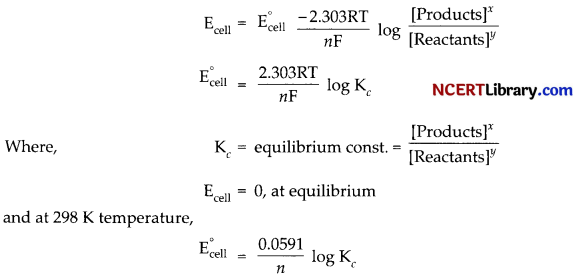
Question 25.
(a) Write the pyranose structure of glucose.
(b) Write the name of common bases present in both DNA and RNA.
(c) What happens when D-glucose is treated with HNO3? [2]
Answer:
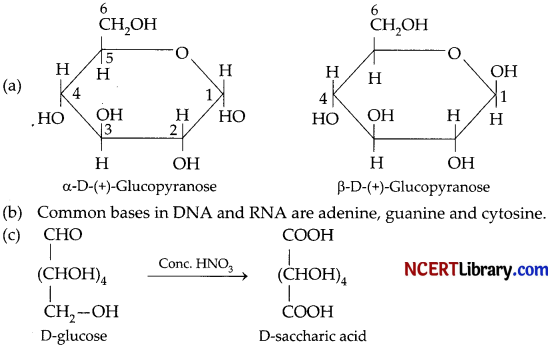
Section – C
This section contains 5 questions with internal choice in two questions. The following questions are short answer type and carry 3 marks each.
Question 26.
Convert the following: [3]
(a) Methyl chloride into ethyl chloride.
(b) Ethyl chloride to propanoic acid.
(c) Diphenyl from chlorobenzene.
Answer:
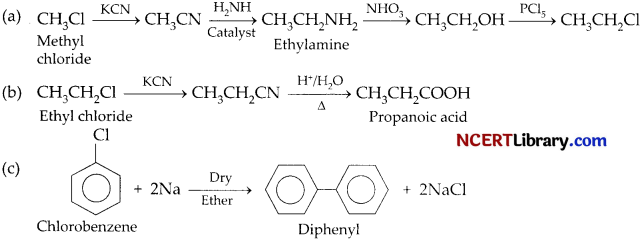
Question 27.
Explain briefly the following reactions. [3]
(a) Hofmann’s bromamide reaction
(b) Gatterman reaction
(c) A coupling reaction
Answer:
(a) Hofmann’s bromamide reaction: When amide is treated with bromide in alkaline solution, and amide yields an amine containing one carbon less than the starting amide.

Example:

(b) Gatterman reaction: When benzene or its derivative is treated with carbon monoxide and hydrogen chloride in the presence of anhydrous aluminium chloride or cuprous chloride, it gives benzaldehyde or substituted benzaldehyde.

Gatterman Koch reaction: Diazonium salt reacts with hydrogen halide in presence of copper powder giving haloarene.

(c) A coupling reaction: Arene diazonium salts react with highly reactive aromatic compounds such as phenols and amines to form brightly coloured azo compounds.
Ar – N = N – Ar. This reaction is known as coupling reaction.

Question 28.
(a) What do you understand by the term glycosidic linkage? [3]
(b) Classify the following into monosaccharides and disaccharides.
Ribose, 2-deoxyribose, maltose, galactose, fructose and lactose.
(c) Write one difference between tt-helix and (3-pleated structures of proteins.
Answer:
(a) Glycosidic linkage refers to the linkage formed between two monosaccharide units through an oxygen atom by the loss of a water molecule.
For example, in a sucrose molecule two monosaccharide units, a-glucose and (3-fructose, are joined together by a glycosidic linkage.
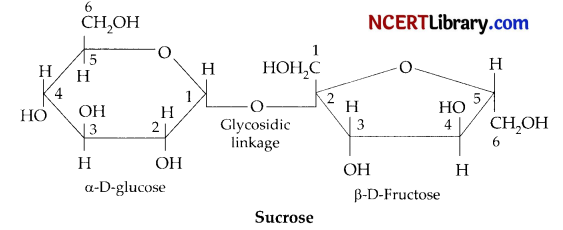
(b) Monosaccharides : Ribose, 2-deoxyribose, Sucrose Galactose, Fructose.
Disaccharides : Maltose, Lactose.
(c) In a-helix structure of proteins, the peptide chains are coiled to form right handed helix involving hydrogen bonding. In (3-pleated structure of proteins, the peptide chains lie side by side joined together by inter-molecular hydrogen bonding.
Question 29.
Answer the following questions:
(a) Transition metals generally form coloured compounds.
(b) Why are Mn2+ compounds more stable than Fe2+ towards oxidation to their +3 state?
(c) Silver is a transition metal but zinc is not. [3]
Answer:
(a) Most of the transition metal ions are coloured both in the solid-state and in aqueous solutions. The colour of these ions is attributed to the presence of an incomplete (n – 1) d-subshell. The electrons in these metal ions can be easily promoted from one energy level to another in the same d-subshell. The amount of energy required to excite the electrons to higher energy states within the same d-subshell corresponds to the energy of certain colours of visible light. Therefore, when white light falls on a transition metal compound, some of its energy corresponding to a certain colour is absorbed causing the promotion of d-electrons. This is known as d-d transitions. The remaining colours of white light are transmitted and the compound appears coloured.
(b) The electronic configuration of Mn2+ is [Ar] 3d5 which is half-filled and hence it is stable. Therefore, the third ionization enthalpy is very high, i.e., the third electron cannot be easily removed. In the case of Fe2+, the electronic configuration is 3d6. Therefore, Fe2+ can easily lose one electron to acquire a 3d5 stable electronic configuration.
(c) According to the definition, transition elements are those which have partially filled d-subshell in their elementary state or in one of the oxidation states. Silver (Z = 47) can exhibit a + 2 oxidation state in which it has an incompletely filled d-subshell (4d9 configuration). Hence, silver is regarded as a transition element.
On the other hand, zinc (Z = 30) has the configuration 3d10 4s². It does not have partially filled d-subshells in its elementary form or in a commonly occurring oxidation state (Zn2+: 3d10). Therefore, it is not regarded as a transition element.
![]()
Question 30.
The following data were obtained during the first order thermal decomposition of SO2Cl2 at a constant volume. [3]
SO2Cl2(g) → SO2(g)Cl2(g)
| Experiment | Time (s-1) | Total pressure (atm) |
| 1 | 0 | 0.5 |
| 2 | 100 | 0.6 |
Calculate the rate of the reaction, when total pressure is 0.65 atm.
OR
In general, the rate of the chemical reaction doubles for an increase of 10 K in absolute temperature from 298 K. Calculate Ea.
Answer:
The thermal decomposition of SO2Cl2 at a constant volume is represented by the following equation.

After time t, total pressure, pt = (p0 – p) + p + p
⇒ Pt = p0 + P
⇒ p = pt – p0
Therefore p0 – p = p0 – (pt – p0)
= 2p0 – pt
For a first order reaction,
k = \(\frac{2.303}{t} \log \frac{\mathrm{P}_0}{\mathrm{P}_0-p}\)
= \(\frac{2.303}{t} \log \frac{\mathrm{P}_0}{2 \mathrm{P}_0-\mathrm{P}_t}\)
When t = 100 sec, k = \(\frac { 2.303 }{ 100 }\) log \(\frac{0.5}{2 \times 0.5-0.6}\) = 2.231 x 10-3 s-1.
When Pt = 0.65 atm,
P0 + p = 0.65
⇒ p = 0.65 – p0 = 0.65 – 0.5
= 0.15 atm
Therefore, when the total pressure is 0.65 atm, pressure of SO2Cl2 is
SO2Cl2 = P0 – p
= 0.5 – 0.15
= 0.35 atm
Therefore, the rate of equation, when total pressure is 0.65 atm, is given by
Rate = k\(\left(p_{\mathrm{SO}_2 \mathrm{Cl}_2}\right)\)
= (2.23 x 10-3 s-1) (0.35 atm)
= 7.8 x 10-4atm s-1.
OR
It is given that T1 = 298 K
∴ T = (298 + 10) K = 308 K
We also know that the rate of the reaction doubled when temperature is increased by 10°.
Therefore, let us take the value of k1 = k and that of k2 = 2k
Also, R = 8.314 JK-1 mol–
Now, substituting these values in the equation :

Section – D
The following questions are case-based questions. Each question has an internal choice and carries 4 (1+1+2) marks each. Read the passage carefully and answer the questions that follow.
Question 31.
Methyl tert-butyl ether appears as a colourless liquid with a distinctive anesthetic-like odour. Vapours are heavier than air and narcotic. Boiling point 131 °F. Less dense than water and miscible in water. Used as an octane booster in gasoline. Methyl tert-butyl ether (MTBE) is a flammable liquid with a distinctive, disagreeable odour. It is made from blending chemicals such as isobutylene and methanol, and has been used since the 1980s as an additive for unleaded gasoline to achieve more efficient burning. Methyl tert- butyl ether is an ether having methyl and tert-butyl as the two alkyl components. It has a role as a non¬polar solvent, a fuel additive and a metabolite.
After careful investigation it has been found that f-butyl ethyl ether can not be prepared by the following reaction.
C2H5-ONa + (CH3)3C – Cl → (CH3)3C – OC2H5
Answer the following questions:
(a) Why the above mentioned reaction does not occur?
(b) What would be the major product of the above reaction instead of f-butyl ethyl ether?
(c) Write the mechanism for the formation of major product in the above reaction.
OR
Write a suitable reaction for the preparation of f-butyl ethyl ether. [3]
Answer:
(a) (CH3)3CCl is a tert-alkyl halide. It does not undergo nucleophilic substitution with C2H5OΘNa⊕ due to steric reason.
(b) Isobutene.
(c)

(d) tert-butylethyl ether is prepared by the reaction between f-butoxide and ethyl chloride involving SN² mechanism.

Question 32.
Van’t Hoff found that electrolytes do not obey osmotic pressure equation (π = cRT). π > CRT. Similar situation is observed for all colligative properties. For electrolytes Van’t his equation π = icRT, ‘i’ is called Vant Hoff factor.
For three different solutions ‘t’ values are tabulated below: [3]
| 0.1M Solution | ‘i’ Values |
| A | 1 |
| B | 0.82 |
| C | 1.53 |
Answer the following questions:
(a) Under what condition ‘i’ value is equal to unity?
(b) What would be the value of T for a dilute solution of K2SO4 is water?
(c) How Y value is related to degree of dissociation-Explain.
OR
Under which condition ‘i’ value is > 1 and < 1 – Explain.
Answer:
(a) When the solute does not undergo any dissociation or association in the solution i.e., for non-electrolyte solution the value of Y is equal to unity.
(b) The value of i for K2SO4 will be:
K2SO4 → 2K+ + SO42-
i = 3.
(c) For an electrolytes if one molecule dissociate into V particles and ‘a’ be the degree of dissociation then after dissociation particles formed from one particle are (1- α + n α)
This is ‘i’.
So, i = 1 – α + n α
OR
When the solute undergo association in the solution ‘i’ becomes < 1 but when the solute undergoes dissociation in the solution ‘i’ becomes > 1.
Section – E
The following questions are long answer type and carry 5 marks each. Two questions have an internal choice.
Question 33.
(a) Define conductivity and molar conductivity for the solution of an electrolyte. Discuss their variation with concentration.
(b) The standard electrode potential (E°) for the cell containing 0.1 M Ag+ and 4.00 M Cu2+ at 298 K are E°
\(\mathbf{E}_{\mathrm{Cu}^{2+} / \mathrm{Cu}}^{\mathrm{o}}=+0.34 \mathrm{~V}, \mathbf{E}_{\mathrm{Ag}^{+} / \mathrm{Ag}}^{\mathrm{o}}\) = + 0.80 V.
Calculate the cell potential (E).
(c) How many hours does it take to reduce 3 mol of Fe3+ to Fe2+ with 2.00 A current?
[R = 8.314 J K-1 mol-1, 1 F = 96500 C]
OR
(a) Calculate the standard cell potentials of galvanic cells in which the following reactions take place:
(i) 2Cr(s) + 3Cd2+(aq) → 2Cr3+(aq) + 3Cd E°\(\mathrm{Cr}^{3+} / \mathrm{Cr}\) = – 0.74 V
(ii) Fe2+(aq) + Ag+(aq) → Fe3+(aq) + Ag(s) E°\(\mathrm{Cd}^{2+} / \mathrm{Cd}\) = – 0.40 V
Calculate the ∆rG° and equilibrium constant of the reactions.
(b) The molar conductivity of 0.025 mol L-1 methanoic acid is 46.1 S cm² mol-1.
Calculate its degree of dissociation and dissociation constant. Given λ°(H+) = 349.6 S cm² mol-1 and λ°(HCOO–) = 54.6 S cm² mol-1. [5]
Answer:
(a) Conductivity of a solution is defined as the conductance of a solution of 1 cm in length and area of cross-section 1 sq. cm. The inverse of resistivity is called conductivity or specific conductance. It is represented by the symbol K. If Q is resistivity, then we can write :
K = \(\frac { 1 }{ ρ }\), units are Ω-1 cm-1 or S cm-1
Conductivity always decreases with a decrease in concentration, both for weak and strong electrolytes. This is because the number of ions per unit volume that carry the current in a solution decreases with a decrease in concentration.
Molar conductivity of a solution at a given concentration is the conductance of volume V of a solution containing 1 mole of the electrolyte kept between two electrodes with the area of cross-section A and distance of unit length.
Λm = k\(\frac { A }{ l }\), Also, Λm = \(\frac { k×1000 }{ C }\), where C = concentration
Now, l = 1 and A = V (volume containing 1 mole of the electrolyte).
∴ Λm = KV
Molar conductivity increases with a decrease in concentration. This is because the total volume V of the solution containing one mole of the electrolyte increases on dilution.
The variation of Λm with \(\sqrt{c}\) for strong and weak electrolytes is shown in the following plot:

Hence, Ecell= 0.3832 V.
(c) For 3 moles of Fe3+ to convert to Fe2+, we require 1 mol of electron charge per mol.
3 Fe3+ + 3e– → 3 Fe2+
Hence 3 moles of electrons are required.
i.e., Q = 3 x 1 F = 3 x 96500 C.
as, 1 F = charge of 1 mol of electron.
Also, Q = It
∴ t = \(\frac { Q }{ t }\) = \(\frac { 3×96500 }{ 2 }\) second
Hence, time in hrs \(\frac { 144750 }{ 3600 }\) = 40.20 hrs.
OR
(a) (i) E°\(\mathrm{Cr}^{3+} / \mathrm{Cr}\) =-0.74 (Given)
E°\(\mathrm{Cd}^{2+} / \mathrm{Cd}\) = – 0.40 V
The galvanic cell of the given reaction is depicted as :
\(\mathrm{Cr}_{(\mathrm{s})}\left|\mathrm{Cr}^{3+}{ }_{(\mathrm{aq})}\right|\left|\mathrm{Cd}^{2+}{ }_{(\mathrm{aq})}\right| \mathrm{Cd}_{(\mathrm{s})}\)
Now, the standard cell potential is
E°cell = E°R – E°L
= -0.40-(-0.74)
= + 0.34 V
∆rG° = -nFE°cell
In the given equation, n = 6
F = 96487 C mol-1
Then, E°cell = +0.34 V
∆rG° = – 6 x 96487 C mol-1 x 0.34 V
= – 196833.48 J mol-1
= -196.83 kJ mol-1
If value of F = 96500 C used then ∆rG° = -196.86 kj/mol (Both are correct) Again,
Again, ∆rG° = – RT In K
⇒ ∆rG° = – 2.303 RT log K
⇒ log K = \(\frac{\Delta_r \mathrm{G}}{2.303 \mathrm{RT}}\)
= \(\frac{196.83 \times 10^3}{2.303 \times 8.314 \times 298}\)
= 34.496
∴ K= antilog (34.496)
= 3.13 x 1034
(ii) \(\mathrm{E}_{\mathrm{Fe}^{3+}}^{\mathrm{°}} / \mathrm{Fe}^{2+}\) = 0.77 V
\(\mathrm{E}_{\mathrm{Ag}^{+} / \mathrm{Ag}}^{\mathrm{°}}\) = 0.80 V
The galvanic cell of the given reaction is depicted as:
\(\mathrm{Fe}^{2+}{ }_{(\mathrm{aq})}\left|\mathrm{Fe}^{3+}{ }_{(\mathrm{aq})}\right|\left|\mathrm{Ag}_{(\mathrm{aq})}^{+}\right| \mathrm{Ag}_{(\mathrm{s})}\)
Now, the standard cell potential is
E°cell = E°R – E°L
= 0.80 – 0.77 = 0.03 V
Here, n = 1. Then,
Then, ∆rG° = -nFE°cell
= – 1 x 96487 C mol-1 x 0.03 V
= -2894.61 J mol-1
= – 2.89 kJ mol-1
Again, ∆rG° = – 2.303 RT log K
⇒ log K = \(\frac{-\Delta_r G}{2.303 \mathrm{RT}}\)
= \(\frac{2894.61}{2.303 \times 8.314 \times 298}\)
= 0.5073
K = antilog (0.5073)
= 3.2 (approximately).
(b) C = 0.025 mol-1
Λm = 46.1 S cm² mol-1
λ°H+ = 349.6 S. cm² mol-1
λ°HCOO– = 54.6 S. cm² mol-1
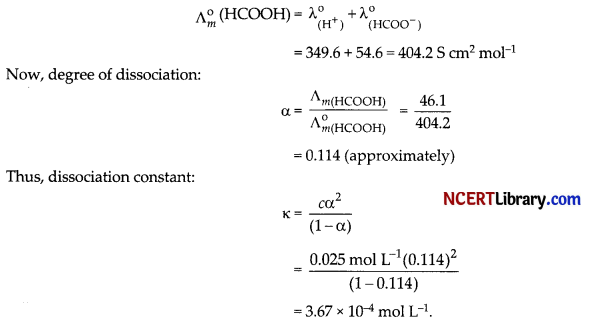
Question 34.
(a) Draw the structures of geometrical isomers of [Fe(NH3)2 (CN)4]–
(b) [NiCl4]2– is paramagnetic while [Ni(CO)4] is diamagnetic though both are tetrahedral. Why?
[Atomic number of Ni = 28]
(c) What is spectrochemical series? How is it formed? [5]
OR
(a) Give the formula of each of the following coordination entities:
(i) CO3+ ion is bound to one Cl–, one NH3 molecule and two bidentate ethylene diamine (en) molecules.
(ii) Ni2+ ion is bound to two water molecules and two oxalate ions. Write the name and magnetic behaviour of each of the above coordination entitles. (At. nos. CO = 27, Ni = 28)
(b) On the basis of crystal field theory, write the electronic configuration for d4 ion if A0 > P
(c) Predict the oxidation number of cobalt in the following complexes.
(i) K[Co(C0)4]
(ii) [CO(C2O4)3]3-
Answer:
(a) Geometrical isomers of complex [Co(en)2Cl2]+:
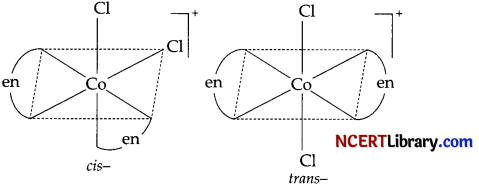
(b) In the presence of strong field ligand CO, the unpaired d-electrons of Ni pair up so [Ni(C04] is diamagnetic but Cl– being a weak ligand is unable to pair up the unpaired electrons, so [Ni(Cl4)]2- is paramagnetic.
In [NiCl4]2- complex ion, nickel is in +2 oxidation state and the configuration is 3d8. Since the molecule is tetrahedral, it involves sp³-hybridisation as shown below:
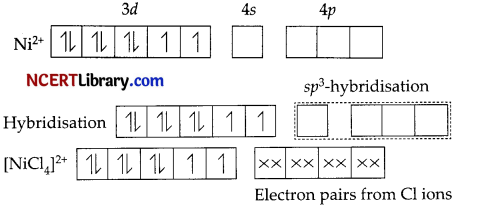
The molecule is paramagnetic because it contains two unpaired electrons.
In [NiCl4] nickel is in O oxidation state and has the configuration 4s² 3d4 or 3d10. The molecule is tetrahedral and involves sp³-hybridisation as given below:

Each CO donates a pair of electrons forming four Ni-CO bonds. The compound is diamagnetic since it contains no unpaired electron.
(c) Spectrochemical series is a series in which the ligands have been arranged in order of increasing field strength.
I– < Br– < SCN < Cl– < S-2 < N3–– < F – < ONO– < OH– < SO4-2 < NO4– < C2O4-2 < O-2 < H2O ~ NCS– < EDTA-4 < NH3 ~ Py < en < bpy ~ phen < NO2– < PR3 < CH3 < CN– ~ CO
From I- To H2O are weak field ligands.
From NCS– To CO are strong field ligands.
It is based on the interaction of metal with ligand. Greater the interaction of the ligand with metal, greater will be the splitting of d-orbitals and thus, strong pairing will take place. It is an experimentally determined series based on the absorption of light by complexes with different ligands.
OR
(a) (i) [CO(NH3) (Cl) (en)2]2+ Ammine chlorido bis-(ethane-l, 2-diamine) cobalt(III) on Co(27).
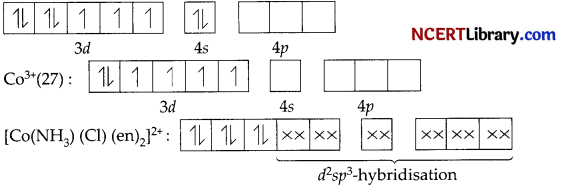
Since there are no unpaired electrons, complex is diamagnetic.
(ii) [Ni(H2O)2 (C2O4)2]2- Diaquadioxatatonickelate(II) ion Ni(28):

The complex has two unpaired electrons, therefore, it will be paramagnetic.

(c) (i) Oxidation number of cobalt in K[Co(CO)4] is – 1.
(ii) Oxidation number of cobalt in [CO(C2O4)3]3- is + 3.
Question 35.
(a) How do you convert the following? [5]
(i) Ethanal to propanone
(ii) Toluene to benzoic acid
(b) Write the products of the following reactions:
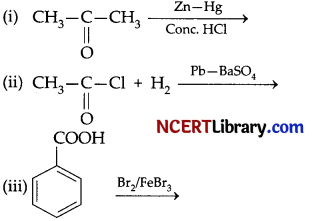
(c) Draw the structures of the following compounds:
(i) 3-Methylbutanal
(ii) 4-Methylpent-3-en-2-one
Answer:
